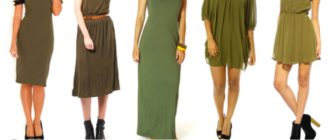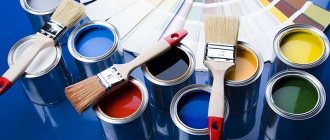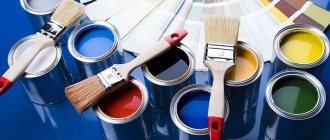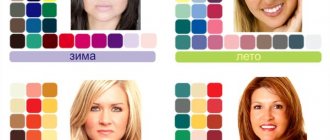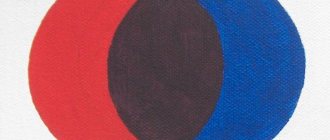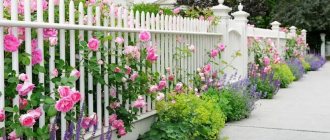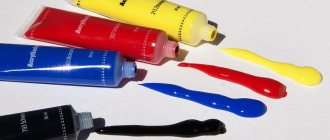How to get turquoise color
In this article we will look at ways to create turquoise color by mixing paints.
Turquoise color is very attractive, harmonious and relaxing. This color has a very good effect on a person and calms him down. Turquoise, also called aquamarine, falls somewhere between green and blue on the color wheel. It ranges from soft, light tones to richer, deeper ones.
If you need a given color, in one shade or another, but you can’t find and purchase ready-made paint, don’t be discouraged by some manipulations of mixing colors, you will achieve the desired result.
Who suits turquoise hair color
You may be interested in: Photos of short women's haircuts that do not require styling: the most stylish options
Before you decide to make such a bold change of image, you need to carefully consider this step and understand whether such a bright color will suit you. Turquoise dye looks good on the hair of girls with fair skin and blue eyes. It will help make their image even more tender and romantic. But dark-haired beauties with dark skin are better off choosing a rich dark blue range of shades.
Once you have decided on a color, you need to decide which dyeing technique to choose for your look. Nowadays there are a lot of them. Ombre, sombre, balayage, shatush - just to name a few.
How to make light turquoise and soft turquoise from paints and gouache when mixed?
The color turquoise is quite popular and in demand today, but its various shades and tones are no less popular. Let's see what we need to get these shades of turquoise.
Before you start mixing paints, you need to prepare the following materials:
- A board on which we will mix paints
- Brush
- White paint
- blue paint
- Green paint
We get turquoise color
When everything you need is already at hand, you can begin the process itself:
- To get the light shade of turquoise we need, take green and blue paint, you can also take a little yellow. Please note that these should be pure shades that are most similar to the standard colors of the spectrum
- Place a certain part of the blue color on a special board and add green in small parts using a brush; if the desired color does not work out, add a drop of yellow paint. Also, to obtain a light turquoise hue, add a little white to the prepared mixture until you see the desired result on the palette
If you need a delicate shade of turquoise for your work, you need to do the following manipulations:
- Take green, blue, white and gray paints
- Apply a certain amount of blue color to a special board
- Mix green and white paint colors separately. Add white in small portions and gradually until you obtain a light green or, as it is called, a pastel green hue.
- Add the resulting pastel green shade to the blue color until you see a soft, creamy, soft turquoise shade
- For an even more delicate, muted shade, you can add a touch of gray paint.
How to make colored cream for a cake from natural dyes
When it comes to decorating homemade baked goods, especially a cake, a lot of questions arise about how to do it beautifully, what techniques should be used, what part of the confectionery product should be decorated. It is worth taking into account fashion trends, which are currently characterized by minimalism in the design of any dishes. This means that when decorating cakes you should feel free to experiment with creams. It is worth not only combining unique tastes, but also colors. To paint a product with rainbow colors, you need to know one secret: how to make colored cream for a cake using food and natural dyes.
How to get a sea green color when mixing paints or gouache?
This color definitely resembles the color of the sea. This color is absolutely appropriate and popular both in creativity and in the wardrobe. So, to get the desired color we need to prepare:
- Green paint
- blue paint
- Sponge
- Brush
- A board on which we will mix paints
Creating an aqua color
Next we follow these instructions:
- Take the 2 paint colors above that are closest to the standard colors on the spectrum and place them side by side on the palette
- Mix the paints until a homogeneous consistency is formed.
- From the added amount of blue, aqua color can vary from soft, faded, lightish tones to richer, deeper and more intense dark green shades
- To get a delicate, pastel shade of sea green, you will need to add a bit of white paint.
Color mixing: table
The process of obtaining one color or another is, in principle, always the same. You need to take all the colors you need, arm yourself with a brush and palette, and then, gradually mixing the paints, achieve the desired color and shade. But immediately remembering which colors need to be mixed to get the desired result is not always so easy. Therefore, we present to your attention a table that will definitely help you quickly cope with this process.
As you can see, getting such a beautiful turquoise color and its different shades is not so difficult. To achieve the desired result, you just need to arm yourself with paints of suitable colors, a brush, a palette, and, of course, add a little imagination to all this.
Turquoise color can be easily obtained by mixing paints. By definition, turquoise is a shade of blue and green, a sea green color, close to cyan. There are a number of ways to achieve turquoise, they will depend on the result the artist wants.
What colors should you mix to get turquoise?
A novice artist is recommended to choose acrylic paints. They are easy to work with, and their combination takes place without much diligence and patience on the part of the student. Tubes of paint have a small volume - this is the most budget option for purchasing.
Sometimes sellers who understand the assortment of their own store or already have successful sales experience can help you choose paints that go well together. Suitable herbal and heavenly tones, purchased on the advice of the staff, will play a huge role in achieving the desired result.
What colors should be mixed to get a pale and rich turquoise shade?
Pale shades are achieved by adding a touch of white, and maybe yellow, to the already familiar blue and green. Those. two colors are gradually added to the existing tones in small quantities: snow-white and sunny. According to the style of the emerging composition, you need to stop at the finished shade. Let's say the drawing is a picture with an element of a tropical beach, then a flesh color is chosen as the basis to obtain the color of the sea water surface. But in its pure form, “artificial” white will serve as an excuse to depict the coldness of some turquoise planet.
This video explains how to achieve diamond color in painting.
The rich color of aquamarine is a different story. To prepare for creativity you need heavenly and grass-colored paint. Next, a small amount of cyan paint is moved onto the palette, and in close contact with it, green paint. It is allowed to immediately identify them in one of the cells.
The lack of green paint is not a reason to be upset. You can do it at home. This color will be given by two colors: heavenly and sunny. But with the lack of a palette, any smooth and dry surface will help, sometimes even a kitchen plate, a thick sheet of paper, a piece of cardboard, or a fireproof tile. Fantasy sometimes suggests incredible ideas in hopeless situations.
The two components should be mixed in a certain proportion: 2 blue and 1 green. Aquamarine color is composed more of sky pigment than grass pigment, so the mixture is formed using this ratio. This proportion should form the basis as a model, but experiments with it will give the desired result.
A rich wave color, like the sea, can be obtained by the following ratio: 2 - blue, 1.5 - grass. A combination of green in a smaller dose will produce turquoise, vaguely reminiscent of blue.
An admixture of solar paint is used in cases where it is necessary to obtain a bright shade. The ratio should be used as follows: 1 – blue, 5 (6) – yellow. You can try variations of the following combination: solar in addition to heavenly and herbal. Is the shade too bright? Use off-white paint to thin it out. White helps soften colors, making them less pronounced.
Turquoise paint color: what shades does it go with?
The color aquamarine, wherever it is used, will always be dominant. Only occasionally can it be added interspersed with bright elements, be it painting or interior design. It is often used as an emphasis on a particular detail, thing, object. To shade it or create a decent background for it, use a neutral palette. For example: beige, light gray, milky, coffee, brown - ideal.
The versatility of this color is obvious. Let's say the designers decided to renovate a room in a classic style and took aquamarine as a basis. Is this a good idea? Certainly! As is the case with the hi-tech style. Ornaments, intensity adjustments, characteristic of one or another will help in creating a masterpiece. And this color is rich in shades like no other...
Fans of extreme options in design and painting can experiment with the following combinations: red-aquamarine, coral, light green, rich yellow.
This video explains and shows how to get bright colors when mixing. Don’t forget to leave your questions and suggestions for the article.
Turquoise color in nature, its meaning
Turquoise is one of the most beautiful shades; it is widespread in the world around us. This tone can be seen on the sea near resort shores; the water in the area of sea lagoons, various oases and water quarries is colored turquoise. Different shades of turquoise are seen in the sky in the early hours of the morning. This color is not present in the main palette; it must be obtained by combining paints.
Psychologists call turquoise cold and mysterious, although people associate it with intimate conversations with friends. In the countries of the East, the color symbolizes faith, healing, compassion, and in Europe it was previously considered a talisman that bestows good luck.
Alternative medicine uses turquoise in color therapy: this shade is good for the eyes, can strengthen the immune system, and reduces the risk of overload, depression and stress. It is believed that this tone is very harmonious, designed to add calmness and balance to a person, and helps control emotions.
Getting a turquoise shade
Making turquoise with your own hands is not difficult. To do this, you can use gouache, watercolor, acrylic paints, you just need to mix them in certain proportions. Since turquoise is a mixture of green with a drop of blue, these two basic tones will be required to prepare the paint.
There are no clear instructions on the number of colors. Search is a creative process where paint standards are selected individually. To work you need:
- white palette or plate;
- tassels;
- a glass of water;
- paper.
You should take a sufficient amount of greenery for work, which does not have foreign impurities, and then add blue drop by drop. The colors should be mixed after introducing each new portion of the material. In any case, the amount of blue paint should be less than green. If a color seems right, you should try it out. To do this, make a smear on the paper - a uniform turquoise tone should remain on it.
There are various shades of turquoise - sea wave, azure, blue-green, as well as curacao, aquamarine, the color of thrush eggs and others, which are exotic to the ears of beginners. It is worth considering the process of making the most popular turquoise halftones in more detail.
Light turquoise
To create a lighter tone, you will need blue paint rather than blue. It is made using the simplest method - adding a little white to the desired degree of lightening. Then they begin to gradually introduce a blue tone into the green until a delicate turquoise tint begins to “emerge.” Also, professionals often add a drop of yellow paint to the mixture - it adds brightness and lightness to the greenery, making it light green, so the finished turquoise will be airy and very beautiful. If the finished tone does not seem delicate enough, it can be diluted with any amount of white paint until a pastel shade is obtained.
Color ratio table for obtaining turquoise
You cannot see turquoise in the spectrum of primary colors; there are only basic tones. But by mechanically mixing paints, you can make almost any desired color. Here is a table with data that will help you navigate the variety of shades of turquoise:
| New color | Connectable colors | Approximate ratio |
| Light turquoise | Blue, green, white or cream | 100:5:2 |
| Soft turquoise | Blue, green, white | 100:10:5 |
| Dark turquoise | Cyan, green | 100:40 |
| Sea wave | Green, blue, white | 100:50:10 |
Even a schoolchild can make the shade in question. Experiments will help you create an original color - all you need is paints, brushes, a palette and a little imagination!
Getting turquoise color by mixing paints
In the color palette, turquoise is located in the middle - between green and blue. The shade is not fixed in a single standard form. It has countless variations: from calm pastel colors to catchy saturated colors. It is not always possible to find the required jar of new paint, so the only possible solution is to get the note yourself by mixing two basic tones. How to get turquoise color when mixing paints?
Mixing Food Coloring: Color Chart and Basic Rules
Food coloring will make your culinary creations bright, original and memorable. To decorate your dishes in all the colors of the rainbow, you don’t have to purchase the entire palette of food colors. It is enough to buy the main colors and get the rest of the shades by mixing.
The main colors are red, blue, yellow, white and black. With these paints in stock, you can get almost any shade.
How to choose paints
The famous color of Tiffany jewelry boxes, in most cases, involves mixing in unequal proportions of green (the majority) with blue (the smaller part). The perfect flower combination has not been invented to create turquoise when mixing paints, so a variety of shades can be achieved.
A delicate pastel tone is obtained as a result of small splashes of gray and white. A mixture of blue, green and yellow acquires a deep and rich coating.
In the video: the basics of mixing colors.
Basic Rules for Mixing Food Colorings
When mixing food coloring, it is important to follow several rules and then the result will definitely please you.
Food pigments are divided into water-soluble and fat-soluble, which is usually indicated on the packaging. Fat-soluble paints are used for coloring chocolate, butter cream, and cocoa butter. For cream, caramel, dough products, glaze, mastic, you should choose water-soluble dyes.
The wrong type of dye will not give you the desired result, or will completely ruin the dish. You cannot mix two types of dyes with each other.
Dyes can also be divided according to the form of release: dry, liquid and gel.
Always test the resulting color on a small part of the dish before coloring the whole thing.
Is it possible to mix dry and liquid food coloring with each other? Experienced chefs do not recommend doing this, as the result may be unpredictable. In order for the color to turn out beautiful, and the dish to be colored evenly and not change the consistency, it is recommended to mix dyes of the same type, release form and manufacturer.
You can buy high quality food colorings on the website 100ing.ru. The catalog includes dry, liquid, gel dyes, kandurin, as well as food markers. If you want to prepare a bright, beautiful dish or product, but do not accept synthetic pigments, pay attention to natural and safe, but no less bright, Luxomix dyes.
Food coloring is a fascinating activity that sometimes produces unexpected results. Experiment, try new things and create unique culinary masterpieces!
For our beloved readers, a 10% discount using the promotional code BLOG on all products weighing up to 15 kg in the online food ingredients store 100ing.ru! Delivery and pickup throughout Russia.
Basis
The principle of obtaining the desired color is clear; it is worth considering other ways to achieve it. Any green and blue base is acceptable: water, oil, acrylic, gouache.
There is a minor nuance in the artistic scheme: it is advisable to mix paints of the same type.
It is advisable to buy materials in specialized stores; it is quite possible to find the expected tone in finished form among a wide assortment.
Watercolor
Emerald, yellow and blue are taken in small drops in order to maintain maximum accuracy. For beginner artists, it is preferable to choose watercolors. It is flexible and easy to handle. Most often, watercolors can be found on sale in tubes. Yellow paint works well with pale tones.
To get a muted turquoise color, you should add a little white to the tandem of blue and green. The use of warm cream is suitable for an artistic depiction of the depths of the sea washing the Cote d'Azur.
I wonder what solutions should be used to implement a space theme on canvas. It would be more appropriate to take a whiter cream color as a basis and use a green blue dye (it is permissible to use variations of ultramarine, azure or cobalt).
All pigments are impregnated with a small proportion of other colors, which is convenient when combining paint of any shade with any other.
All shades of red
The persistent coloring properties of beets are well known. By adjusting the intensity of its juice, you can easily prepare excellent cream for a cake without dyes at home, from pink to deep red. To do this, you need to grate a small beet, fill it with water and cook for an hour. To make the color intense and beautiful, add a pinch of citric acid to the broth. Don’t forget about all kinds of red berries: raspberries, strawberries, lingonberries, currants, cranberries, dogwoods. By the way, preserves, jams and syrups based on them can be used to create creams in red shades with the same success. Cherry and pomegranate juices will also do the job perfectly. And red wines will give the cake cream not only a pleasant color, but also exquisite aromatic and taste notes.
Rich shade
In the process of mixing two basic tones, you can resort to the ideal solution: make blue paint with green pigment.
There is no standard pure foundation. For example, it is believed that blue in tandem with yellow acquires a green color, and with red - purple. In reality, the edges are blurred: the main color tends to green or red due to the imperfect chemical transparency of each individual pigment.
To get a turquoise color, and the deepest one, you need to use the indicated blue and green.
- Apply a drop of cyan paint (blue-green) to the edge of the palette.
- Near the cyan one, place a little green. If green paint is not available, you should prepare it yourself: mix yellow and blue in equal proportions on any clean and always dry surface.
- To get the color, you need to mix blue and emerald in a 2:1 ratio. Deviations in the ratios are possible, but for the first experimental time it is desirable to maintain the specified balance. By adding green, the shade will deviate towards the sea green color, reducing its amount - blue will appear more noticeable in turquoise.
Saturated color
Fun and bright design with your own hands: how to get yellow from paints and plasticine
So, to solve the question of how to get turquoise color when mixing paints, blue and However, you can achieve an even better result. For this we will use blue paint containing green pigments. It is impossible to find a “pure” base.
In particular, this applies to the color blue. In theory, it should produce a good green with yellow, and an excellent purple with red. In practice, these lines become blurred. The fact is that blue always approaches red or green due to the imperfect chemical purity of each pigment.
To obtain an extremely rich color, we take the necessary ingredients. We are talking about the already familiar blue and green shades.
- Apply a small amount of cyan paint to the edge of the palette. In this case it should be blue-green.
- Let's move on to the next step. Place some green paint nearby. If you don't have it, you can get this color yourself. To do this, mix equal amounts of yellow and blue. Instead of a palette, any clean, dry surface will do. However, an item that is used in this way can no longer be used for anything else.
- Mix blue and green in a 2:1 ratio. There should be more of the first pigment. You can also experiment with proportions, but it is better to use the given ratio as a guide. A slightly larger amount of green paint will give a rich aqua shade. If you reduce the green content, you get a subtle turquoise. It will get closer to blue.
So we figured out what elements the turquoise color consists of. How to get it is described in detail above.
One of the most beautiful colors on earth is turquoise. It amazes with its piercing and beauty, incomparable with any other color. In common parlance it is called the color of the sea wave. Turquoise color is very fashionable, it is used in interior design, clothing and much more. It is widely used in home interiors, but you should not overdo it, as you can achieve an unsatisfactory result; it is better to harmonize it with various shades of other colors. The turquoise color in any interior brings extremely positive emotions.
He has always commanded respect from people engaged in public service and difficult mental work, as he has the ability to provide assistance in making the right decisions. Turquoise was considered the imperial stone of ancient Egypt, and after death, turquoise was used to decorate their tombs. Turquoise color consists of several shades: green-blue and blue. Turquoise is a cool color, but compared to other colors in the same group it is the warmest. Like many other colors, turquoise has its own meaning and influence on people. This color brings a feeling of freshness and natural purity.
Turquoise color has a very strong effect on a person, it can relieve irritability and fatigue. The difference in its shades is wide - from soft turquoise to deep blue-green. Turquoise color is used in the design of health spas and massage rooms. It is usually combined with white. This is not surprising, since it, like no other, gives a feeling of calm and relaxation. Doctors have found its significant impact on recovery in rehabilitation centers.
In addition, doctors advise being surrounded by him most of the time in order to achieve the best result. So how do you get turquoise? To do this, you need to mix several paints of different colors. You can get turquoise shades by taking blue or blue-green paint and mixing it with white. To make turquoise at home, you will need blue and green paints. It is desirable that these be the purest shades, close to standard samples of the color wheel. You need to take a small amount of blue paint and mix in a little green paint.
It all depends on the artist what shade he wants in the end, bluish or greenish, you just need to keep adding green to get the desired result. In order to achieve maximum color brightness, it is necessary to use a palette of undiluted paints. The color largely depends on the paints used; it is preferable to use watercolor and gouache paints, since only they are able to more accurately convey the brightness of the color of turquoise. It is not difficult, and everyone can afford to make and use this beautiful color. You need to try and experiment, draw and enjoy the beautiful.
Turquoise color in nature, its meaning
Turquoise is one of the most beautiful shades; it is widespread in the world around us. This tone can be seen on the sea near resort shores; the water in the area of sea lagoons, various oases and water quarries is colored turquoise. Different shades of turquoise are seen in the sky in the early hours of the morning. This color is not present in the main palette; it must be obtained by combining paints.
Psychologists call turquoise cold and mysterious, although people associate it with intimate conversations with friends. In the countries of the East, the color symbolizes faith, healing, compassion, and in Europe it was previously considered a talisman that bestows good luck.
Alternative medicine uses turquoise in color therapy: this shade is good for the eyes, can strengthen the immune system, and reduces the risk of overload, depression and stress. It is believed that this tone is very harmonious, designed to add calmness and balance to a person, and helps control emotions.
Getting a turquoise shade
Making turquoise with your own hands is not difficult. To do this, you can use gouache, watercolor, acrylic paints, you just need to mix them in certain proportions. Since turquoise is a mixture of green with a drop of blue, these two basic tones will be required to prepare the paint.
There are no clear instructions on the number of colors. Search is a creative process where paint standards are selected individually. To work you need:
- white palette or plate;
- tassels;
- a glass of water;
- paper.
You should take a sufficient amount of greenery for work, which does not have foreign impurities, and then add blue drop by drop. The colors should be mixed after introducing each new portion of the material. In any case, the amount of blue paint should be less than green. If a color seems right, you should try it out. To do this, make a smear on the paper - a uniform turquoise tone should remain on it.
There are various shades of turquoise - sea wave, azure, blue-green, as well as curacao, aquamarine, the color of thrush eggs and others, which are exotic to the ears of beginners. It is worth considering the process of making the most popular turquoise halftones in more detail.
Light turquoise
To create a lighter tone, you will need blue paint rather than blue. It is made using the simplest method - adding a little white to the desired degree of lightening. Then they begin to gradually introduce a blue tone into the green until a delicate turquoise tint begins to “emerge.” Also, professionals often add a drop of yellow paint to the mixture - it adds brightness and lightness to the greenery, making it light green, so the finished turquoise will be airy and very beautiful. If the finished tone does not seem delicate enough, it can be diluted with any amount of white paint until a pastel shade is obtained.
When light turquoise still needs to be “cooled,” you can add a little gray paint to the finished color scheme. That is, they mix green, blue, white and gray tones. The result is an unusual muted color, perfect for painting pictures of the sky.
Dark turquoise
Making dark tones of turquoise yourself is also easy. To do this, you should purchase cyan paint, which already has a green tint with a hint of blue (sold in an artist store). You need to put a little of this paint on the palette, then add the usual green color in small portions. The dark turquoise color is achieved by adding a small amount of greens, and thorough mixing is very important. Some specialists add a little brown to darken the tone even more; this color will be a little warmer than ordinary turquoise.
Aquamarine
Sea color is obtained in a similar way. It will require two standard colors - blue and green - in approximately equal proportions. They are mixed until smooth, then a tiny amount of white paint is added for some lightening. Depending on the amount of white, the sea green color will change from rich to paler. Professionals call marine color a mixture of blue phthalocyanine and titanium dioxide, but for the average person, ordinary (classic) gouache from a store is quite suitable.
